Estimating the Benefit of Robusta Coffee Production in Semarang and Banjarnegara
 https://doi.org/10.22146/aij.v6i1.53951
https://doi.org/10.22146/aij.v6i1.53951
Tasneem Hasan
(1*), Paputsara Supamoon
(2), Noveliska Br Sembiring
(3), Adi Djoko Guritno
(4)
(1) Department of Agribusiness, Faculty of Agriculture, Chiang Mai University, Thailand
(2) Department of Agribusiness, Faculty of Agriculture, Chiang Mai University, Thailand
(3) Department of Agroindustrial Technology, Faculty of Agricultural Technology, Universitas Gadjah Mada, Indonesia
(4) Department of Agroindustrial Technology, Faculty of Agricultural Technology, Universitas Gadjah Mada, Indonesia
(*) Corresponding Author
Abstract
Indonesia is one of the top world coffee producers with a production level reached 654,120 metric tons in 2017, dominated by Robusta. In that country, 96% of coffee plantation area is cultivated by small-scale farmers. Besides improving the welfare of farmers and allowing a soil erosion reduction, the cultivation of the coffee plant, especially those grown by small-scale farmers, requires a study on the economic aspects of its supply chain, which provides an estimation of the coffee production benefits. Therefore, the research aims to analyze the economic aspects of upstream activities in the coffee supply chain and present the scenario through the five years of profitability. To achieve the research aims, surveys and observations were carried out on small-scale coffee farmers in Banjarnegara, a district in Central Java Province with soil erosion in the past, and Semarang, a district in the same province with a high area of coffee plantation. Data collection was carried out on three parties, namely farmers, collectors, and traders, by focusing on the income share and market channel. Later, the scenario of coffee production which is constructed by the benefit value calculation of the representative of a farmer with a high level of productivity was presented in the paper. We conclude that the progress on the development of Robusta coffee production scenario, when integrated with crop production systems can significantly improve industry preparedness, benefit, and productivity. The scenario used cost and benefits values and simulated the growth of the coffee tree with crops (in Banjarnegara). The additional result of coffee supply chain formula’s showed that crop forecasting offers substantial benefits of coffee growers and industry through five years of increased profitability. Indonesia is one of the top world coffee producers with a production level reached 654,120 metric tons in 2017, dominated by Robusta. In that country, 96% of coffee plantation area is cultivated by small-scale farmers. Besides improving the welfare of farmers and allowing a soil erosion reduction, the cultivation of the coffee plant, especially those grown by small-scale farmers, requires a study on the economic aspects of its supply chain, which provides an estimation of the coffee production benefits. Therefore, the research aims to analyze the economic aspects of upstream activities in the coffee supply chain and present the scenario through the five years of profitability. To achieve the research aims, surveys and observations were carried out on small-scale coffee farmers in Banjarnegara, a district in Central Java Province with soil erosion in the past, and Semarang, a district in the same province with a high area of coffee plantation. Data collection was carried out on three parties, namely farmers, collectors, and traders, by focusing on the income share and market channel. Later, the scenario of coffee production which is constructed by the benefit value calculation of the representative of a farmer with a high level of productivity was presented in the paper. We conclude that the progress on the development of Robusta coffee production scenario, when integrated with crop production systems can significantly improve industry preparedness, benefit, and productivity. The scenario used cost and benefits values and simulated the growth of the coffee tree with crops (in Banjarnegara). The additional result of coffee supply chain formula’s showed that crop forecasting offers substantial benefits of coffee growers and industry through five years of increased profitability.
Keywords
Coffee supply chain; Cost and benefits scenario; Market channel; Robusta coffee
References
International Coffee Organization. 2018. Trade statistics table report 2018: Total quantity of coffee by exporting countries [Internet]. Available from: http://www.ico.org/trade_statistics.asp. Accessed on 9 August 2018.
Teguh, W Misnawi, J. 2018. Challenges of Sustainable Coffee Certification in Indonesia. In: International Coffee Organization Seminar (ICO Seminar) 2012. [Internet]. Available from: http://www.ico.org/event_pdfs/seminarcertification/certification-iccri-paper.pdf. Accessed on 9 August 2018.
Irfan, A. Indonesia Coffee Market. 2018. Chairman of Association of Indonesia Coffee Exporters and Industries. Proceedings of Association of Indonesia Coffee Exporters and Industries Conference, 7 November 2014, Bali, Indonesia. [Internet]. Available from: file:///C:/Users/Administrator.KKDV2- 20140929K/Downloads/Indonesiancoffee. pdf . Accessed on 14 August 2018.
Ratna, L and Samsul, M. 2013. Pola Keterkaitan Sentra Produksi Dan Sentra Pengolahan Komoditas Perkebunan di Kabupaten Banjarnegara. Jurnal Teknik PWK, Volume 2, Number 4.
Farid, T. Instructor, Department of Energy and Mineral Engineering, The Pennsylvania State University. GeoResources Evaluation and Investment Analysis. Benefit Cost Ratio. [Internet]. 2018. Available from: https://www.eeducation.psu.edu/eme460/node/608 [Accessed: 16 August 2018]
Tevfik F. Nas. 2018. Cost-Benefit Analysis: Theory and Application, 2nd edition. Lexinglon Books.

DOI:
https://doi.org/10.22146/aij.v6i1.53951
Article Metrics

Abstract views : 1799
|

views : 1425
Refbacks
- There are currently no refbacks.
Copyright (c) 2020 Tasneem Hasan, Paputsara Supamoon, Noveliska Br Sembiring, Adi Djoko Guritno

This work is licensed under a
Creative Commons Attribution-ShareAlike 4.0 International License.









